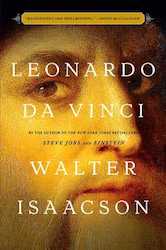
This was simultaneously fascinating and frustrating. Da Vinci was clearly a genius, and Isaacson’s treatment of his varied interests and talents was thorough, enlightening, and inspiring. But I “read” this book solely on audio (with the downloadable pdf of the illustrations), and because of that, I suppose, I kept losing focus through the long work.
I have gotten into the habit of late of reading paper books while I listen to the audio versions. I have found that the pacing is a little slower that way and I concentrate and focus better. When I listen to the audio alone, however, my mind wanders easily and I either have to accept missing whole passages or replaying them with renewed focus. For a long biography such as this one, I found that frustrating.
That drawback of my own reading process aside, Da Vinci’s story is fascinating. Of course, even someone with my little art history background knows about the Mona Lisa and The Last Supper, but learning of his incredible work as a scientist, inventor, engineer, and architect, made me rethink the whole idea of a polymath–a genuine Renaissance Man. The scope of Da Vinci’s interests and talents is breathtaking.
Da Vinci doesn’t fit the mold, however, of the quirky genius in many regards. He was affable, preferred working with people than in isolation, was liked by everyone. And a man truly after my own heart, he failed to finish so many of the projects he conceived. Not that I consider myself a Da Vinci, but I rival him in ideas never completed. (His ideas were simply all better ones and he had so many, he was forever abandoning projects to begin new ones.)
Isaacson is a wonderful biographer. His research is completely thorough, his spirit is generous but fair, and his enthusiasm for his subjects is clear. There’s been much written about Da Vinci, of course, but Isaacson’s work is a very welcome new assessment of this remarkable man.
I have gotten into the habit of late of reading paper books while I listen to the audio versions. I have found that the pacing is a little slower that way and I concentrate and focus better. When I listen to the audio alone, however, my mind wanders easily and I either have to accept missing whole passages or replaying them with renewed focus. For a long biography such as this one, I found that frustrating.
That drawback of my own reading process aside, Da Vinci’s story is fascinating. Of course, even someone with my little art history background knows about the Mona Lisa and The Last Supper, but learning of his incredible work as a scientist, inventor, engineer, and architect, made me rethink the whole idea of a polymath–a genuine Renaissance Man. The scope of Da Vinci’s interests and talents is breathtaking.
Da Vinci doesn’t fit the mold, however, of the quirky genius in many regards. He was affable, preferred working with people than in isolation, was liked by everyone. And a man truly after my own heart, he failed to finish so many of the projects he conceived. Not that I consider myself a Da Vinci, but I rival him in ideas never completed. (His ideas were simply all better ones and he had so many, he was forever abandoning projects to begin new ones.)
Isaacson is a wonderful biographer. His research is completely thorough, his spirit is generous but fair, and his enthusiasm for his subjects is clear. There’s been much written about Da Vinci, of course, but Isaacson’s work is a very welcome new assessment of this remarkable man.
 RSS Feed
RSS Feed
